A Famous Father, a Talented Daughter, and a Quirky Treatise
Angélique Diderot, Keyboardist and Composer
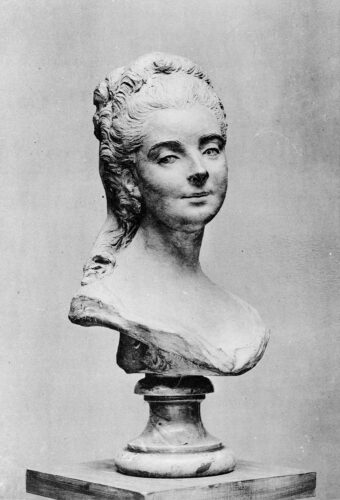
How did women in the early modern world learn to compose music? Across Europe and its colonies, girls and women were generally restricted from studying in institutions that taught topics in music theory — harmony, counterpoint, solfège, and improvisation — that were essential to becoming composers.
Gaining access to an education in these subjects was no small task. Church choir schools, which educated many composers, were for boys. But some girls had other opportunities. They might learn composition if they came from families of professional musicians and were taught by their relatives. Think, for example, of Francesca and Settimia Caccini, the daughters of the composer Giulio Caccini. Trained by their father, Francesca and Settimia both became prominent singers and learned to compose. Francesca, supported by the Medici court of Florence, even wrote and published an opera in 1623, The Liberation of Ruggiero from the Island of Alcina. (The opera is on its way toward repertoire status: Alcina was a hit of the 2023 Boston Early Music Festival and will receive a new production in September by Chicago’s Haymarket Opera.)
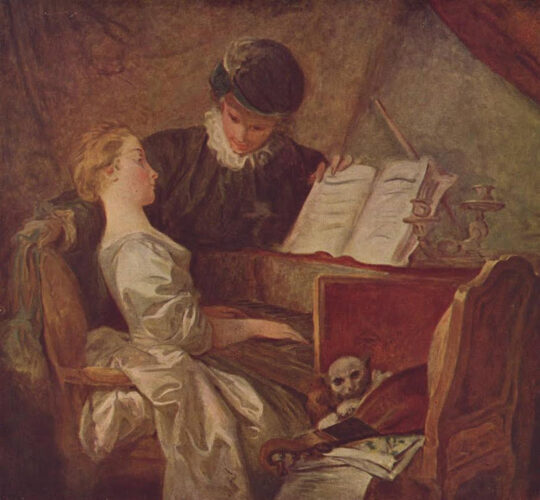
If women attended a salon, they might encounter other women who composed, and who might share their skills within their social circle. One example is Anne-Louise Brillon de Jouy, who wrote music for her salon gatherings, where she welcomed leading intellectuals such as Benjamin Franklin and Charles Burney and professional musicians like Luigi Boccherini.
If, like Isabella Leonarda and many others, they joined female communities where composition was practiced — the convent, primarily — they could learn from other women within those walls or from the professional male composers who were sometimes engaged to teach them.
Even in these cases, however, the status of composer, like the status of “author” more generally, could be fraught. Social conventions, especially among the bourgeois and upper classes, meant that assertion of an authorial voice could subject women to unwanted scrutiny and accusations of impropriety. As the 18th century wore on, influential writers like Jean-Jacques Rousseau argued that women should be kept off the stage and out of the public intellectual sphere. The novelist Fanny Burney, daughter of the aforementioned music historian Charles Burney, was intensely aware that her forays into published authorship were risky. As a result, she published her first novel anonymously and, initially, hid her authorship from her father; only later did her identity as the work’s creator become known. The taboo on women’s authorship and musical composition continued for generations, and some might suggest that it continues to hold sway, affecting women’s participation in the field of composition even today.
And yet a significant number of women somehow did learn to compose. Many wrote music for private use within their families or immediate social circles. Some put their work out into the world through publication. Attention to the avenues by which individual women learned the craft of composition can shed new light on their subjective experiences, and it can help us understand how those experiences might manifest themselves in their music.
Some might suggest the taboo on women’s composition continues to hold sway, affecting women’s participation in the field even today.
One woman who learned to compose was Marie-Angélique Diderot (1753–1824), daughter of the famed French philosophe Denis Diderot. Denis carefully curated Angélique’s education, arranging for her to receive private instruction with tutors in a wide range of subjects, including some that were considered inappropriate for young ladies such as human anatomy. She showed talent in music from a young age: Charles Burney referred to her as “one of the finest harpsichord-players in Paris.”
Like many girls and women, Angélique received private instruction in music. However, her lessons did not stop at music as a social grace. Because her father wanted her to learn the theoretical underpinnings of music — he valued systematic learning in every field — her lessons encompassed composition.
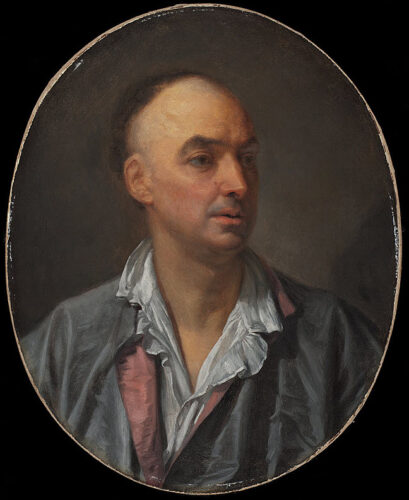
Angélique’s one surviving work, a prelude, appears in a treatise published under the name of her teacher, Anton Bemetzrieder, titled Leçons de clavecin et principes d’harmonie (1771).
The treatise probably reflects Bemetzrieder’s music-pedagogical method. Its language and construction, however, were determined by her father, who ghost-wrote the book.
Angélique’s prelude was intended primarily as a demonstration of the effectiveness of Bemetzrieder’s pedagogy and Denis’ enlightened approach to his daughter’s education. Although the treatise was a space controlled by these two men, Angélique’s prelude — a highly unusual piece, almost avant-garde for its day — shows her asserting her compositional voice. It highlights how she drew on the pathways available to her to share her expressive, creative artistry.
(My recording of the piece is at www.raritanplayers.org/diderot and, as far as I know, had not previously been recorded.)
‘A suitable pastime for girls’
From the time Angélique was young, her father worried about her education and her prospects in life. On the one hand, Denis disdained the frivolity that, in his view, dominated the lives of many women, who occupied themselves with fashion and socializing, and he cultivated Angélique’s intellectual life by arranging for her to have private lessons with tutors in a range of subjects. (His relentless work as primary editor of the Encyclopédie helped to pay for these tutors and to secure Angélique’s dowry.)
On the other hand, even as he invested in Angélique’s education, he embraced the widespread understanding of women as intellectually inferior to men. In 1772, with his essay “Sur les femmes”(“On Women”), Denis explained that women’s emotions and intellectual capacities were governed by the vagaries of their uncontrollable anatomy; thus, in his view, women could never achieve the kind of intellectual control that was necessary to cultivate a strong authorial voice. “Sur les femmes,” written when Angélique was not yet 20, suggests that women were far better at conversation — especially the stylized, performative conversation that characterized French salons — than they were at creating original literary or artistic works.
Denis Diderot’s idea that women’s verbal abilities were confined to the art of conversation, rather than written literature, resonates with widespread ideas about women’s engagement with music. Accomplishment in singing or playing an instrument was widely seen as a suitable pastime for girls and women — one that would keep them occupied innocently and, when displayed properly, increase the chances of a good marriage. In contrast to musical performance, composition required understanding of harmony, melody, and voice leading, as well as the large-scale architecture of musical forms.
It was therefore natural that Denis should cast doubt on women’s ability to compose original music and, indeed, in the Leçons de clavecin he expressed skepticism about women’s composition as a whole. At the same time, however, he allowed his daughter to learn composition, elevating her as a musical author even as he dismissed that possibility for most other women.
The Stress Test
The Leçons de clavecin is primarily a treatise about tonal harmony. It posits Bemetzrieder’s “law of appellation,” which divides notes in the scale into those that “call to” other notes (most obviously, the tonic — the point of rest) and those that are “called to” return to that point of rest. Through practice at the keyboard, the student learns this harmonic system in a hands-on, practical manner.
In the process of outlining this harmonic theory, the Leçons de clavecin also asks whether women have the capacity to write their own music. It teaches skills necessary for the student to become a composer — especially the art of harmonic modulation — but it claims that the status of “composer” depends on something more: the presence of genius.
An ineffable, unteachable quality, “genius” is the prerequisite to the act of musical authorship. Without it, the would-be composer does nothing more than combine a sequence of harmonies as tailors stitch together pieces of fabric. Throughout the treatise, and in “Sur les femmes,” the implication is that women are less likely than men to possess the quality of genius, though, when they do, their genius is “more original” than men’s. In this context, Angélique’s study of music becomes the stress test that proves the efficacy of Bemetzrieder’s pedagogical system.
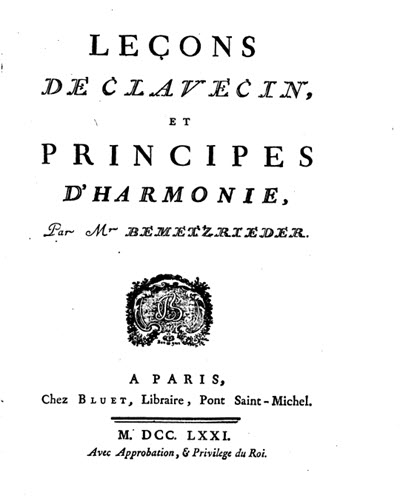
Presented as a series of dialogues, the Leçons de clavecin features three main characters, whose identities are revealed only at the end: Le philosophe (the Philosopher, Denis Diderot), Le maître (the Teacher, Bemetzrieder), and L’élève (the Student, Angélique Diderot). These dialogues trace the Student’s quest to master the Teacher’s principles of harmony so that she can attain independence in the act of musical creation, whether through figured bass accompaniment, improvisation, or composition.
The possibility that Angélique possesses exceptional qualities that distinguish her from other women is suggested early on, in a scene in which the Teacher first hears the Student play the harpsichord. The Philosopher presses the Teacher for an assessment of the Student’s capacity, and the Teacher replies in distinctly gendered terms: “The piece that Mademoiselle has just played” — a work by Carl Philipp Emanuel Bach — “is beautiful and difficult; she has well-placed hands; it will be up to her to excel. Her lively physiognomy shows penetration. I do not know if she will ever compose, but if she composes, she will create strong music; for I see that she prefers that to music that is fine and delicate.” The implication here is that “strong music” is unusual for women.
But the question of whether Angélique possesses the quality of genius necessary to be a true composer remains unresolved until the very end of the treatise, following hundreds of pages of harmonic pedagogy with examples and exercises that she must practice. Finally, she informs her teacher that she plans to surprise her father by playing an original composition — a prelude, one of twelve that she has written. She refuses to allow her teacher to see the composition in advance, since she wants it to be entirely her own work.
The day of the presentation arrives, and the Student (Angélique) prepares to play her composition for her father. But before she begins to play, she is overcome by emotion: She trembles, she cries, and she can only speak in fragmentary utterances rather than full sentences. She starts to play, stops, and starts again, before proceeding to play through the whole prelude. Angélique’s trembling, tears, and fragmented speech are markers of a state of “enthusiasm,” defined by the Encyclopédie as “a kind of furor that takes hold of the spirit and masters it, which ignites the imagination, elevates it, and renders it fruitful. It is a state of transport, one might say, that makes a person say or do extraordinary and surprising things.”
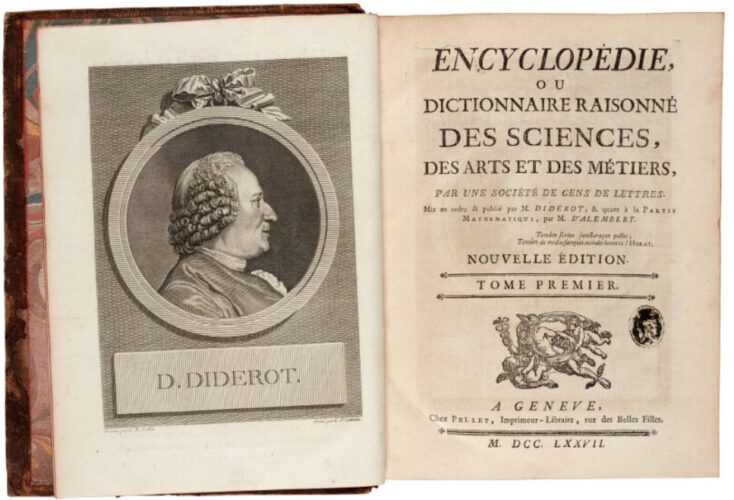
Moreover, the Encyclopédie emphasizes that “there is no enthusiasm without genius.” Thus, the Leçons de clavecin confirms that Angélique has achieved a state of genius — and, therefore, presumably, that her work is the work of a true composer. Here, the treatise devotes four pages to printing the score of her prelude.
The Prelude as Fantasy
Denis Diderot insisted that the Leçons de clavecin represented Angélique’s studies with Bemetzrieder faithfully. When he sent the published book to Burney, Denis claimed, “there is nothing in this work that is not the most exact truth.” Yet this claim of verisimilitude cannot be taken at face value, since it clearly reflects the agendas of her teacher and father. Most obviously, the sentimental framing of her performance of her prelude is suspect. Is it possible that Angélique was so moved at the moment of her performance that she trembled, cried, and fumbled for words?
Perhaps. But it is far more likely that Denis invented this portrayal of enthusiasm to align with conventional notions of artistic inspiration that had already become widespread across Europe. This scene calls Denis’s claims of verisimilitude into question.
In the absence of Angélique’s first-hand account, it may never be possible for us to gain a completely accurate picture of her experience and her ideas. However, consideration of her prelude can shed new light on her perspective.
That Angélique’s composition is in the prelude genre is telling. Within France, there was a history of including preludes in pedagogical works — think, for example, of the eight preludes in François Couperin’s The Art of Playing the Harpsichord (1716). A more immediate precedent, however, are the fantasies of C.P.E. Bach, whose music Angélique played when she first met Bemetzrieder, as noted above.
The eighteen sample pieces appended to Bach’s Essay on the True Art of Playing the Keyboard (1753) conclude with the famous Fantasy in C minor (Wq. 63/18) — a didactic work meant to demonstrate the quasi-improvisatory aspects of the fantasy as a genre. The prelude was the French equivalent of the fantasy; these genres involved the expectation of harmonic adventurousness, as the composer sought to capture the spirit of improvisation in a composed work.
Even when playing a composed fantasy or prelude, the performer was meant to adopt the posture of improvisation, dramatizing harmonic surprises and playing with great flexibility. Indeed, the French verb préluder and the German verb fantasieren both meant “to improvise.”
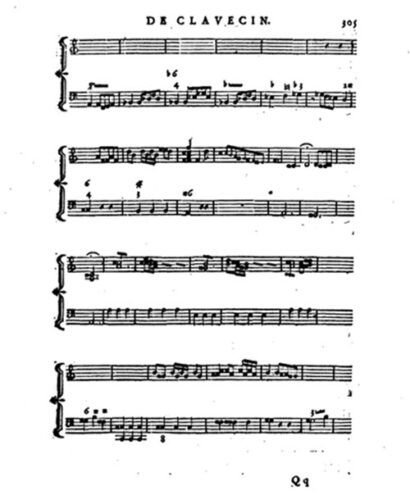
Angélique’s prelude takes Bach’s notion of the fantasy even farther, in that it bridges the acts of composition and improvisation. She adopts a fragmentary manner of notation, in which the right-hand part is only partially notated. In many places, she writes a melody in the right hand but supplements it with bass figures that suggest that the harmony should be filled out through the addition of inner voices.
The clearest instance of this practice is when she calls for an elaborated cadenza toward the end of the prelude. In other spots, Angélique leaves the right-hand part completely unnotated, requiring the player to rely only on the figured bass line to realize the harmonies.
Here, the keyboardist must move through difficult progressions, finding suitable solutions to the complexities of voice leading in extreme keys. The final measures can be especially perplexing, since they return to the opening key of the prelude: G-sharp Major — a key with eight sharps, and one that was so complex that few other 18th-century compositions, if any, use it.
Given that her prelude could more easily be played in the equivalent key of A-flat Major, why did Angélique opt for the more difficult key of G-sharp? My sense is that it shows how well she understood and managed complicated harmonies. It is as if she was saying, “I have so much education in the harmony that I can embed myself in the most extreme key imaginable and still find my way out.”
To be sure, this display of compositional virtuosity validates Bemetzrieder’s pedagogical system, but it also allows Angélique to display her own erudition. Throughout the prelude, she moves to impossibly distant keys, slipping from one to the next through chromatic bass motion, respellings of diminished seventh chords, and the straightforward assertion of unprepared chords. These are techniques cultivated in C.P.E. Bach’s Essay and used by the foremost composers of fantasies or preludes of the age.
After the notated prelude, the Leçons includes a long analysis that it attributes to Angélique. Here, she explains her harmonic thinking, chord by chord, measure by measure. This passage suggests that Angélique fully understood the harmonic scheme of the piece, and it thus attests to her rational, intellectual approach as a complement to the expression of sentiment and enthusiasm that characterized her performance.
Thus, although Angélique’s prelude requires the performer to simulate improvisation, and even to complete the harmonies through improvised realization of the figured bass line, it simultaneously — perhaps defiantly — affirms her skill as a composer.
While Angélique Diderot undertook the study of composition through private instruction, an episode in the reception of the Leçons de clavecin elucidates another means by which women could learn the art of composition: engagement with the treatise itself. After Denis Diderot sent the Leçons de clavecin to Burney in London, Burney replied:
I am charmed with the beginning of the Leçons de Claveçin, I have had time to read little more of it — the Dialogue & doctrine seem equally excellent & Madlle Diderot’s prelude est très savant en modulati[on]. I have formed a design of proving the practicability of M: Bemetzrieder’s Method upon one of my own daughters who plays pretty well on the Harpsichord; but who has not learned as yet, either accompaniment or Modulation. . . . This will be a fair Trial, & if she fails it will only prove the Superiority of Madlle Diderots Genius, which enabled her in so short a Time to acquire a knowledge in Modulation to which so few of her sex have ever arrived.
Here, Burney simultaneously dismissed the possibility that women could become composers and opened the possibility that his own daughters might learn the craft of composition. In fact, Burney’s account is confirmed in the diary of his daughter Fanny, who wrote, “Susette and myself are extremely engaged at present in studying a book lately published under M. Diderot’s direction, which he sent to papa, upon Music.”
Did Susan and Fanny Burney aspire to compose? Did Denis’s sanctioning of his daughter’s composition offer license to Charles Burney to allow his daughters to pursue this goal? Like Diderot, Burney could easily have engaged the finest teachers in London to instruct his daughters in the art of composition; instead, he offered them access to Bemetzrieder’s quirky Leçons de clavecin.
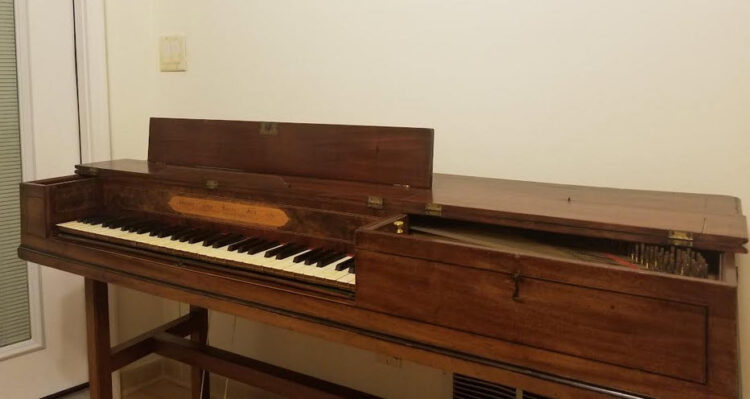
Whatever the answers to these questions, Angélique Diderot’s foray into composition offers a window onto the experience of 18th-century women in music. It illustrates both the biases and obstacles that they encountered and the ways in which they circumnavigated those obstacles to become creative, expressive artists.
Rebecca Cypess is associate dean for academic affairs and associate professor of music at Mason Gross School of the Arts, Rutgers University. Her recent publications include Women and Musical Salons in the Enlightenment (2022) and she co-edited the collection Music and Jewish Culture in Early Modern Italy. A historical keyboardist, Cypess is the founder and director of the Raritan Players. For EMA, she’s written about Ignatius Sancho, an Eighteenth-Century Black Englishman.

